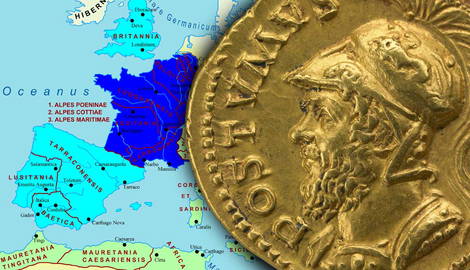
The Gallic Empire, or the Gallic Roman Empire, was a breakaway state that arose during the so-called Crisis of the Third Century. The powerful and independent state emerged as a result of a grave military and political situation facing the Roman Empire during this turbulent period. At its apex, the Gallic Empire encompassed all of Gaul, Britain, Spain, and parts of Germania. For fourteen years, Gallic emperors commanded armies on the Rhine, protecting their subjects from the barbarian raids. Despite its success, the Gallic Empire ultimately fell to the legions of Emperor Aurelian in 274, who restored the unity of the Roman world.
The Gallic Empire Was the Product of a Revolt

The Gallic Empire emerged in 260 CE following one of the worst catastrophes in Roman history. In 253, the Sassanian army annihilated the Roman legions in the East and captured Emperor Valerian, the first (and last) Roman ruler who fell into enemy captivity. The catastrophe in the East, and the defeat of the imperial army, left western provinces denuded of troops. Valerian’s son and heir, Emperor Gallienus, focused on the defense of Italy, while Gaul and the frontier at the Rhine had to fend for themselves. It was only thanks to Postumus, a respected general of the Gallic legions, that the province was saved. However, Postumus’ triumph led to his usurpation, as the aristocrats and soldiers of Gaul saw him as their protector, unlike the distant Gallienus. After assassinating Gallienus’ son Saloninus, Postumus declared himself the emperor. This marked the establishment of the Gallic Empire.
Postumus Created a Powerful Empire

Gallienus considered Postumus the usurper and declared war. However, due to the emergence of another breakaway state – the Palmyrene Empire – and other crises, Gallienus had no choice but to accept the Gallic Empire. In Gaul, Postumus was seen as a hero, a successful military commander respected by the troops and local magnates. After all, Postumus dedicated his entire reign to protecting the region against external threats, most notably the Alamanni and the Franks. Interestingly, his victory over the barbarians in 260 CE was decisive one, as we do not hear of further raids during Postumus’ ten-year rule. As a result, the independent and mighty Gallic Empire would last for fourteen years and encompass most of the western Roman provinces, including Gaul, Britain, and Spain.
The Gallic Empire Was the Roman Empire

However, the Romans, including Postumus himself, never considered the Gallic Empire a separate entity. Unlike the Palymrene Empire in the East, ruled by Zenobia, Postumus’ “Imperium Galliarum” was as Roman as the Roman Empire under the control of Gallienus. Postumus was the Roman emperor. The capitals of Cologne and Trier had their imperial court, senators, and even the praetorian guard. Postumus also minted coins in which he presented himself as a legitimate Roman ruler. If the central government could not defend the Rhine limes, the Gauls would do it themselves. In fact, they would do it for Rome too. And Postumus did just that. After his campaign across the Rhine in 262-263, the frontier remained quiet.
Postumus Was Killed by His Own Soldiers

In a way, Postumus was a soldaten kaiser or soldier emperor, one of many military leaders who ascended the throne during the turbulent Third Century following the demise of the Severan Dynasty. Yet, he was also remarkably successful and ruled for almost ten years. Yet, in the end, his fate mirrored that of soldier emperors. In 269, after defeating the usurper Laelanius, who also happened to be one of Postumus’ top military commanders, the emperor forbade his soldiers to sack the city of Mainz. Angered by such a decision, Postumus’ soldiers assassinated their emperor.
The Gallic Empire Outlived its Founder, But Not For Long

Postumus was the first emperor of the Gallic Empire. He was also the most successful, as his successors faced increased pressure from both barbarians and, more importantly, the Roman emperor. Already under Marius and Victorinus, the Gallic Empire lost southern Gaul and parts of Spain. Both the emperors were assassinated by their own men. When the last Gallic emperor, Tetricus, took the throne in 271, his empire was on the verge of collapse. Most importantly, Rome was now ruled by the ambitious and highly successful Emperor Aurelian, who was determined to restore the unity of the Roman world.
Emperor Aurelian Eliminated the Gallic Empire

After he crushed the power of the Palymrene Empire of Zenobia, bringing the eastern provinces back under the control of Rome, emperor Aurelian turned his gaze to the West. In 274, Aurelian’s legions defeated the army of Tetricus in the decisive Battle of Chalons (near Châlons-sur-Marne, France). Tetricus and his son surrendered to Aurelian, while the army of Gaul disintegrated. Fourteen years after its inception, the Postumus’ Empire was no more. Tetricus was brought to Rome and paraded along Zenobia in Aurelian’s triumph. However, according to Historia Augusta, Aurelian spared the last emperor of the Gallic Empire, and appointed him as a governor in Italy.
By returning the western regions back under the imperial umbrella, Emperor Aurelian restored the unity of the Roman World. Yet, the turbulent period for the Roman Empire would continue for several decades, until Diocletian ascended the throne in 284 CE, establishing the Tetrarchy.










